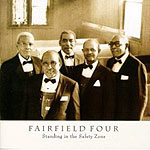
A non-traditional nod to tradition
|
This review first appeared in the June 19, 1992 issue of the North County Blade-Citizen (now North County Times).
The Fairfield Four's combination of artistic integrity and popular accessibility would be pretty hard to beat in the gospel field. And after a half-century of performance, you might think they'd be beyond taking chances.
You'd be wrong, though. Even on a chestnut like "Swing Low, Sweet Chariot," they take a very nontraditional approach. The tempo is slowed down to a dirge on the opening, as with most arrangements, but after the break the Fairfield Four takes a hard left. Rather than just picking up the tempo, the band changes the entire course of the song, with different lyrics, more contemporary harmonies and a more daring construction of the verses and refrain than generally heard on a standard.
If this is a near-perfect example of how a veteran combo, steeped in tradition, can still have the vision and heart to push the boundaries of their art, it's only one example of many on the vocal quartet's new album. In fact, it's pretty much the theme of this album. Excepting only two, every song here is a traditional standard from the early days of gospel, and even stretching back to pre-gospel spirituals and hollers. Each performance, while clearly drawn from and respectful of the rural Southern traditions which gave birth to these songs, still pushes the boundaries of what is considered "gospel."
Although there may well be some gospel fans who will disapprove of such non-traditional arrangements, this improvisational approach is the ultimate expression of love and respect for tradition: hand the form to the next generation with more than it had when you received it.
